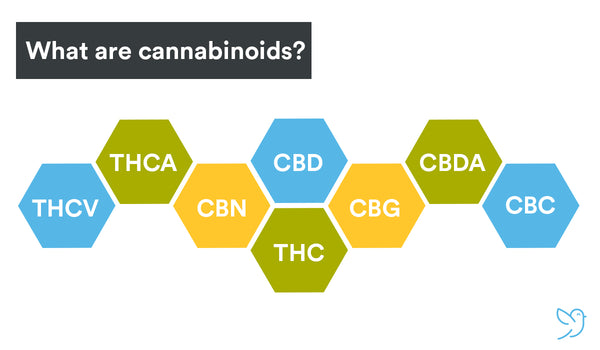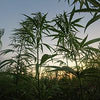What Are Cannabinoids and How Do They Work?

You’ve probably heard the word “cannabinoid” tossed around before. If you're a Bluebird customer, you've even interacted with them, particularly CBD and THC. But what exactly are cannabinoids, what do they do, and how do they work?
Cannabinoids are chemical compounds that interact with the body’s endocannabinoid system. There are three distinct classes of cannabinoids: endocannabinoids, phytocannabinoids, and synthetic cannabinoids. Endocannabinoids are produced by the body; phytocannabinoids are created in plants; synthetic cannabinoids are manufactured artificially.
The most well-known phytocannabinoid is THC - tetrahydrocannabinol. That’s the psychoactive molecule that causes the “high” of cannabis. THC causes these effects via the CB1 receptor on the surface of our cells.
The second most famous cannabinoid is easier to work with because it doesn’t get people high. Known as CBD, cannabidiol also ranks as the second most prevalent cannabinoid in the cannabis plant. CBD is often known as the “yin” to the “yang” of THC. It can calm the effects of THC as well as contribute to balance around the rest of the body. As a CBD manufacturer, we don’t make medical claims for these products in compliance with state and federal regulations, but we do encourage people to research more on their own. CBD has been found to have dozens of different targets at the biochemical level, which helps explain why it’s been found to be helpful for such a wide range of people.
Besides these two cannabinoids, over 110 others have been discovered in the cannabis plant. In addition, cannabis is especially rich in terpenes - the molecules that give smell to many of the foods and fruits that we consume. When all of these cannabinoids and terpenes are working together, their impact seems to be more powerful. This combination is known as the entourage effect, and it’s why we believe in full-spectrum plant extracts for harnessing all the powers of cannabis.
Phytocannabinoids are also known to occur in several plant species besides cannabis. Check out some of the most recognizable non-cannabis plants that contain cannabinoids!
Echinacea
Echinacea, a member of the sunflower family, is a plant genus with ten species that are commonly found in a variety of medicinal and supplemental products. What many people don’t know about echinacea is that it contains a type of phytocannabinoid called alkylamides or alkamides which are designed to help your body absorb nutrients. These alkylamides are agonists of the body’s CB2 receptors.
While echinacea can be a powerful supplement to enhance your body’s natural defenses, it can also potentially interact with a variety of prescription medications. Please consult your doctor before adding this supplement to your diet.
Kava
You’ve probably wandered past a kava bar or two in your lifetime and written them off as fancy wine bars. While kava bars are joining wine bars as a new social hotspot in the U.S. for merriment and relaxation, the star ingredient is quite different from the fermented grape juice you’re used to.
Kava, or kava kava, is a member of the pepper family and commonly found in the South Pacific islands. Its roots are used to create a beverage that can produce mild sedative and euphoric effects. This is due to the presence of over 15 compounds called kavalactones that behave similarly to cannabinoids. One particular kavalactone called yangonin behaves very similarly to THC in that it binds directly to CB1 receptors, producing similar effects but with significantly less intensity. Kavalactones also inhibit the reuptake of norepinephrine and dopamine, contributing to the pleasurable effects.
While kava is generally safe to use in moderation, excessive consumption has been linked to liver disease and other health complications. Use caution and control when giving this popular beverage a try.
Liverwort
Liverworts are another hidden gem in the natural world. They’re also one of the most widespread. The genus Radula encompasses 9,000 species that can be found almost anywhere in the world but most common in the tropics. These nonvascular plants typically thrive in moist soil and on damp tree trunks and rocks and reproduce through the distribution of tiny spores.
What’s interesting about the Radula marginata species in particular is that researchers have discovered a THC-like phytocannabinoid called perrottetinene, or PET. PET and its acidic form, perrottetinenic acid, are partial agonists of both CB1 and CB2 receptors. Due to this affinity, curious folks have discovered that smoking liverwort produces similar effects to smoking weed. However, there has not been nearly enough research to prove that doing so is safe. In other words, stick to cannabis for the time being.
Helichrysum
Another member of the sunflower family joins this list as a producer of cannabinoids. Helichrysum is a genus consisting of 600 species of flowering plants in the sunflower family. Various species of this perennial herb have been historically used in supplements and other body care products, including our very own Hemp Sport CBD Lotion.
However, one species in particular fits in particularly well with our full-spectrum extracts - Helichrysum Umbraculigerum. The reason this species is so special is because scientists have discovered that it is a prolific producer of phytocannabinoids, including two of our favorites - CBG and CBGA. It also produces its own unique phytocannabinoids that are different but similar in structure to those found in the cannabis plant. However, there has not been enough scientific research to understand the affinity of these phytocannabinoids to the cannabinoid receptors. Thus, the effect of helichrysum on the endocannabinoid system remains unclear for the time being.
Black truffles
If you’ve come across black truffles, you’re probably living a life of luxury. Truffles are a species of fungus belonging to the Tuber genus that are highly prized in European cuisines and in international haute cuisine. Black truffles, in particular, are the second-most commercially valued species of truffles in the world.
One of the fascinating traits of black truffles that perhaps lends to their popularity is the presence of anandamide. Anandamide, also known as the “bliss molecule” due to its Sanskrit translation, is one of the endocannabinoids produced by the human brain. Even more interesting is the fact that while black truffles contain anandamide, they lack the receptors that anandamide binds to.
Researchers believe this trait evolved as an ancient signal to animals to eat them in order to spread their spores.
Cacao
People have enjoyed dark chocolate for centuries for many reasons. Theobroma cacao is a species of tree whose seeds and beans are used to make chocolate and cocoa products. Culturally, chocolate is seen as a delightful treat for reasons beyond its delicious taste. Cacao is a source of all kinds of feel-good chemicals, including caffeine, theobromine (a stimulant similar to caffeine), serotonin, tryptophan, and our MVP again - the bliss molecule, anandamide.
So, the next time you turn to chocolate for a little pick-me-up, know that you’re pleasing both your taste buds and your endocannabinoid system!
A word of caution - some of these plants on this list are scientifically recognized but have not been studied and proven safe for consumption. This is by no means a recommendation to use these plants as alternate sources of cannabinoids. If you’re considering trying any extracts derived from the plants listed in this article, please consult a medical professional prior to doing so.
However, if you’re in the market for cannabinoids derived from award-winning hemp extracts, you’re in the right place!
Still have questions about CBD? Check out our free guide, Finding Success with CBD, to learn more.










